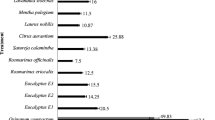Abstract
A phytotoxic substance (C23H44O3) which is named ‘Substance A’, was purified from olive leaves infected withCycloconium oleaginum Cast. The mutagenic effect of this substance was detected using TA 100 and TA 102 strains ofSalmonella in the Ames test usingBacillus subtilis strains M45 rec−, H17 rec+ in the rec assay. Another substance manifesting the mutagenic effect was found in the extract from theCycloconium oleaginum culture. This substance was not detected in the extract from contaminated olive leaves. Substance A increased electrolytes leakage from tissue of olive leaves, thus manifesting its phytotoxicity.
Similar content being viewed by others
References
Guechi, A, Yahiaoui R, Lukasova E, Girre, L. Mise en évidence d'un métabolite secondaire substance A produit parCycloconium oleaginum, champignon pathogène des feuilles d'olivier. Rev Univ Sci Technol Université de Constantine 1991; 2: 1–39.
Guechi, A, Yahiaoui E, Lukasova E Girre L. Sur la présence d'une substance phytotoxique dans les feuilles d'Olea europea L., parasitées par leCycloconium oleaginum Cast. Pharm Acta Helvetiae 1992; 3: 70–75.
Durbin RD. Host specific toxins: Recognition and specificity factors in plant disease. Tottari Université Japan 1989; 1: 135–42.
Bean GA, Fernando TA, Jarvis BB, Bruton BD. The isolation and identification of trichothecene metabolites from plant pathogenic strains ofMyrotheaum roridum. J Nat Prod 1984; 47: 727–29.
Mitchell RE. The relevance of non host-specific toxins in the expression of virulence by pathogens. Ann Rev Phytopathology 1984; 22: 215–45.
Kuti JO, Ng TJ, Bean GA. Phytotoxic effects of trichotecene metabolite from pathogenic strains ofMycothecium roridum onCucumis melo. Biodeterioration Res 1987; 1: 213–22.
Kuti JO, Ng TJ, Bean GA. Possible involvement of a pathogen-produced trichothecene metabolite inMyrothecium leaf spot of muskmelon. Physiol Molec Plant Pathol 1989; 34: 41–54.
Scheffer RP. Toxins as chemical determinants of plant disease. In: Daley JM (ed.), Toxins and Plant Pathogenesis, New York, 1983: 1–40.
Kada, T, Hirano K, Shirasu Y. Screening of environmental chemicals mutagens by rec assay system withBacillus subtilis. In: Serres FJ, Holaender A (eds.), Chemical mutagens, principles and methods for their detection. New York: Plenum, 1980: 149–173.
Ames BN. A bacterial system for detecting mutagens and carcinogens. In: Sutton HE, Harris M (eds.), Effects of environmental contaminants, New York: Academic Press, 1972: 57–66.
Otsuji N, Horiughi T, Nakata A, Kawamata J. Strains ofEscherichia coli hypersensitive to representative carcinostatic and carinogenic agents. J Antibiotics 1978; 31: 794–97.
Mazza G.Bacillus subtilis rec assay test with isogenetic strains. Appl Environ Microbiol 1982; 43: 177–84.
Levin DE, Yamasaki E, Ames BN. A newSalmonella tester strain TA 97 for the detection of frameshift mutagens: A run of cytosines as a mutational hot-spot. Mutation Res 1982; 94: 315–30.
Shuter W, Jager I. Comparative evaluation of different pairs of DNA repair-deficient and DNA repair-proficient bacterial tester strains for rapid detection of chemical mutagens and carcinogens. Mutation Res 1982; 97: 1–18.
Maron DM, Ames BN. Revised methods for theSalmonelia mutagenicity test. Mutation Res 1983; 113, 173–215.
Ames BN, Lee FD, Durston WE. An improved bacterial test system for the detection and classification of mutagens and carcinogens. Proc Nat Acads Sci USA 1979; 70: 782–86.
Rinkus SJ, Legator MS. Chemical characterization of 465 known or suspected carcinogens and their correlation with mutagenic activity inSalmonella typhimurium system. Cancer Res 1979; 39: 3299–3318.
Stossl A. Antifungal compounds produced by higher plants. Recent Adv Phytochem 1970; 3: 143–180.
Kuc J. Phytoalexins. Ann Rev Phytopathol 1972; 10: 207–232.
Byrde RJW, Cuttings CV. Fungal pathogeniciy and the plant's response. New York: Academic Press, 1973.
Strobel GA. Phytotoxins. Ann Rev Biochem 1982; 51: 309–33.
Bell AA. Biochemical mechanism of disease resistance. Ann Rev Plant Physiol 1981; 32: 21–81.
Singh RS. Introduction to principles of plant pathology. New Delhi, Bombay, Calcutta: University Press and IBH Publishing Co., 1984.
Ingham, JL. Phytoalexins and other natural products as factors in plant disease resistance. Bot Rev 1972; 38: 343–424.
Author information
Authors and Affiliations
Rights and permissions
About this article
Cite this article
Yahiaoui, R., Guechi, A., Lukasova, E. et al. Mutagenic and membranal effect of a phytotoxic molecule isolated from olive leaves parasitized by the fungusCycloconium oleaginum Cast. Mycopathologia 126, 121–129 (1994). https://doi.org/10.1007/BF01146204
Received:
Accepted:
Issue Date:
DOI: https://doi.org/10.1007/BF01146204




